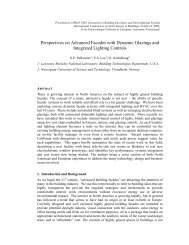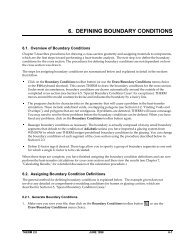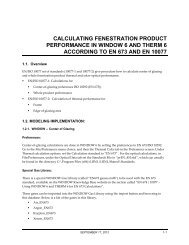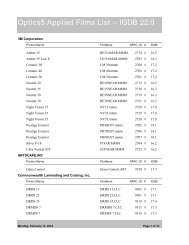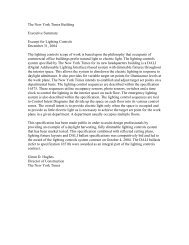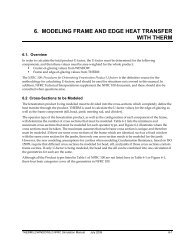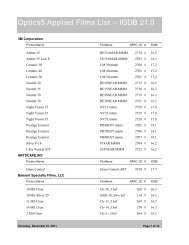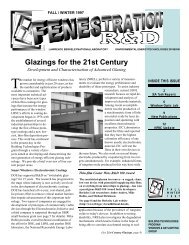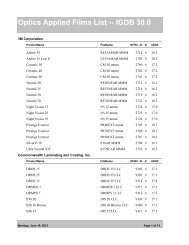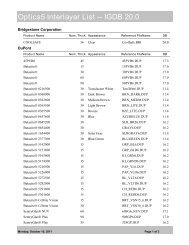Moving from Niche to Mainstream Markets - Windows and ...
Moving from Niche to Mainstream Markets - Windows and ...
Moving from Niche to Mainstream Markets - Windows and ...
You also want an ePaper? Increase the reach of your titles
YUMPU automatically turns print PDFs into web optimized ePapers that Google loves.
<strong>Moving</strong> <strong>from</strong> <strong>Niche</strong> <strong>to</strong> <strong>Mainstream</strong> <strong>Markets</strong>:Addressing the High Cost of Daylighting SystemsTranscript of a lecture given byGlenn Hughes, Managing Direc<strong>to</strong>r of Construction, The New York Times atLightFair International: Daylighting Institute, New York, New York, May 6, 2007
NOTICEThis report was prepared by the Lawrence Berkeley National Labora<strong>to</strong>ry (LBNL) <strong>and</strong>The New York Times Company (hereafter the “Contrac<strong>to</strong>r”) in the course of performingwork contracted for <strong>and</strong> sponsored by the New York State Energy Research <strong>and</strong>Development Authority <strong>and</strong> the U.S. Department of Energy (hereafter the "Sponsors").The opinions expressed in this report do not necessarily reflect those of the Sponsors orthe State of New York, <strong>and</strong> reference <strong>to</strong> any specific product, service, process, or methoddoes not constitute an implied or expressed recommendation or endorsement of it.Further, the Sponsors <strong>and</strong> the State of New York make no warranties or representations,expressed or implied, as <strong>to</strong> the fitness for particular purpose or merchantability of anyproduct, apparatus, or service, or the usefulness, completeness, or accuracy of anyprocesses, methods, or other information contained, described, disclosed, or referred <strong>to</strong> inthis report. The Sponsors, the State of New York, <strong>and</strong> the Contrac<strong>to</strong>r make norepresentation that the use of any product, apparatus, process, method, or otherinformation will not infringe privately owned rights <strong>and</strong> will assume no liability for anyloss, injury, or damage resulting <strong>from</strong>, or occurring in connection with, the use ofinformation contained, described, disclosed, or referred <strong>to</strong> in this report.ACKNOWLEDGEMENTSThis work was supported by the New York State Energy Research <strong>and</strong> DevelopmentAuthority <strong>and</strong> by the Assistant Secretary for Energy Efficiency <strong>and</strong> Renewable Energy,Office of Building Technology, State <strong>and</strong> Community Programs, Office of BuildingResearch <strong>and</strong> St<strong>and</strong>ards of the U.S. Department of Energy under Contract No. DE-AC03-76SF00098.ii
<strong>Moving</strong> <strong>from</strong> <strong>Niche</strong> <strong>to</strong> <strong>Mainstream</strong> <strong>Markets</strong>:Addressing the High Cost of Daylighting SystemsTranscript of a lecture given byGlenn Hughes, Managing Direc<strong>to</strong>r of Construction, The New York Times at LightFairInternational: Daylighting Institute, New York, New York, May 6, 2007This is a talk about how The New York Times approached the cost of these au<strong>to</strong>matedroller shade <strong>and</strong> daylighting control systems.We did not have an unlimited budget. I was not <strong>to</strong>ld, "Glenn it doesn't matter how muchit costs. Go ahead <strong>and</strong> do this." So I had <strong>to</strong> figure out ways <strong>to</strong> make this reasonable. Itried <strong>to</strong> achieve what we called our "big, hairy, audacious goal", which is a HarvardBusiness Review term <strong>and</strong> it was an idea in the mid-1990's saying, "Create a st<strong>and</strong>ard or abar of excellence that is so high you can't even imagine how you could get there," <strong>and</strong>then say, "That's what we have <strong>to</strong> do." And accept that you may never get there, but thatit's going <strong>to</strong> give you some breakthroughs. If you try <strong>to</strong> just incrementally get betteryou'll miss some of the great ideas in this world.So we went for our big hairy audacious goal: dimmable lighting at no premium. I didn'tget us there, but I <strong>to</strong>ok us a long way down that road. I brought it way down <strong>to</strong> where wethink The New York Times <strong>and</strong> I think the marketplace will find out it is truly palatable,especially with the increasing energy costs that we're going <strong>to</strong> face in the future. It's hard<strong>to</strong> say what the energy savings are worth, because - well, what year are you going <strong>to</strong>pick? And if I pick ten years <strong>from</strong> now <strong>and</strong> use somebody's prediction of what energy isgoing <strong>to</strong> cost in the United States, it would be easier <strong>to</strong> justify these projects <strong>and</strong> the sameinvestment is still there. So I think this is going <strong>to</strong> pay back much, much greater than we1
imagine in <strong>to</strong>day's world with a myopic view when we look at what energy costs are<strong>to</strong>day <strong>and</strong> we say, "What's the return on investment? Is it two years or five years or sevenyears?" You have <strong>to</strong> think about what's happening <strong>to</strong> the cost of energy as well. Justthink about the gas that you're putting in your cars if you own them. I haven't owned onefor seven years, so I haven't felt that pinch, but I'm sure plenty have.Lighting energy savings. With just the daylighting controls alone, with LawrenceBerkeley National Lab's help, we proved that we could save 30 percent - almost withouteven trying based on the type of window wall we have, the clarity of the glass, the heigh<strong>to</strong>f the ceiling, all the things I've <strong>to</strong>ld you about - that was just pretty much h<strong>and</strong>ed <strong>to</strong> us: a30 percent savings, as long as the system works properly. And if you push it a little bit,you can get it <strong>to</strong> somewhere around 50 percent. We also have the target setpoint. Insteadof 50 footc<strong>and</strong>les, which is the design output level of our lighting system, what if we godown <strong>to</strong> 40 footc<strong>and</strong>les, what if we go down <strong>to</strong> 30 footc<strong>and</strong>les? Well, now we're starting<strong>to</strong> save 20 percent, 40 percent that way. All spaces aren't going <strong>to</strong> be down at 30footc<strong>and</strong>les, but some will. So we've got a mix, somewhere between 30 <strong>and</strong> 40footc<strong>and</strong>les is what I think is where we're going <strong>to</strong> l<strong>and</strong> for the vast majority of our space<strong>and</strong> we'll have some down at 20 footc<strong>and</strong>les, we'll have a few at 50 footc<strong>and</strong>les, but we'regoing <strong>to</strong> end up somewhere in the 30 <strong>to</strong> 40 footc<strong>and</strong>les range. So that's a significantsavings over the st<strong>and</strong>ard lighting set up in a building. We looked at that <strong>and</strong> we said,"Well, using last year's energy costs here in New York City, we could save $15,000 ayear based on reducing our lighting energy with the combination of daylighting <strong>and</strong>reduction in the target set points. And I think that's conservative. I'm not going <strong>to</strong> giveyou the materials <strong>and</strong> installation cost per square foot, so don't even bother <strong>to</strong> ask me.Now because we are using less lighting, we're using less air conditioning <strong>and</strong> a quicktranslation or correlation between those kilowatt-hours <strong>and</strong> BTUs tells me that we aresaving another $5,000 on air conditioning costs because our lighting levels are that muchlower than would have been otherwise. So we're looking at $20,000 a floor, our floorsare 25,000 square feet, a pretty modest size.We also, <strong>and</strong> this is where it gets qualitative, believe that these systems enhance the waywe work. They make us better at what we do by living in a world full of natural light <strong>and</strong>less electric light <strong>and</strong> a dynamic workspace that's changing, that you allow your body <strong>to</strong>feel the changes of Mother Nature. This leads <strong>to</strong>, we believe, productivity improvements,but we don't know how <strong>to</strong> measure that. I wish I did. We ran around the country, wetalked <strong>to</strong> a number of people <strong>and</strong> nobody convinced us that they really know how <strong>to</strong>measure productivity yet. So that's one of those great open <strong>to</strong>pics for some reallysignificant research in this generation of people coming up now. There are a lot ofpeople going <strong>to</strong> school, grad school, going <strong>to</strong> college right now that are interested in thesetypes of systems <strong>and</strong> care about it <strong>and</strong> believe in it <strong>and</strong> maybe they will be the ones thatcan get this done now.2
The au<strong>to</strong>mated shade system: what is it made up of? It's made up of digital addressablemo<strong>to</strong>rs with encoders. The encoders are telling the shade how far <strong>to</strong> move for thedifferent preset heights. They're addressable mo<strong>to</strong>rs so that we can individually controlthem, either with our manual override on the <strong>to</strong>uch screen or with our shade controlalgorithms. There are pho<strong>to</strong>sensors. There are the manual override stations themselves.There's the wiring of these systems <strong>and</strong> there's the commissioning. So those are the basiccomponents. Let's see how we can save some money talking about these.So first, how many mo<strong>to</strong>rs are there in the system? If you would imagine the simplestpossible world, <strong>and</strong> this is how somebody estimated the job when I first suggested it, oneof our owner reps said, "Well, every 5 feet of your curtainwall is going <strong>to</strong> be a shade,right?" And I said, "Yes, we're going <strong>to</strong> have <strong>to</strong> have a shade b<strong>and</strong> in every glasswindow. That's true." Okay. So they assumed one mo<strong>to</strong>r per 5-foot curtain wallmodule. So every shade b<strong>and</strong> had its own independent mo<strong>to</strong>r. Wow, is that reallynecessary? Why would you have one shade b<strong>and</strong>, one mo<strong>to</strong>r? So when we built themock-up, we pushed back <strong>and</strong> said we want four shade b<strong>and</strong>s per mo<strong>to</strong>r or control ofeach 20 feet of shade. And after they did that, I wrote in the spec we want 30 feet. Soright now we've been delivered 30 feet. So there's one mo<strong>to</strong>r instead of six. We've saved84 percent of the cost of wiring mo<strong>to</strong>rs simply by going <strong>from</strong> a one-<strong>to</strong>-onecorrespondence <strong>to</strong> a 1-<strong>to</strong>-6 correspondence. This is the kind of thinking but my ideasaren't the only answer here. Again, all we say is that we've opened the door, opened yourmind. This is the way <strong>to</strong> approach things <strong>and</strong> you'll find lots of ways <strong>to</strong> save money.Pho<strong>to</strong>sensors. How many pho<strong>to</strong>sensors do we need? We talked about that earlier.There's a lot of ways <strong>to</strong> reduce the number of pho<strong>to</strong>sensors if you can. And how do younetwork them? I think there are a lot of opportunities <strong>to</strong> find savings. LBNL has talkedabout how we piggybacked the pho<strong>to</strong>sensors in the lighting control system right on theDALI loop. So the pho<strong>to</strong>sensor is in the light right next <strong>to</strong> the ballast. The pho<strong>to</strong>sensorwas delivered with a 29-inch flying lead. All the electrician - <strong>and</strong> it was already trimmed- had <strong>to</strong> do was drop the two leads in<strong>to</strong> two pressure terminals on the ballast <strong>and</strong> thelighting sensor was in service. Done! This is a tremendous savings, instead of runninganother whole loop for the pho<strong>to</strong>sensors in the lighting controls.The manual override stations. When we first approached this, in the mock-up <strong>and</strong> we hadtwo different companies showing us what they could do. We said, "Okay, we're going <strong>to</strong>3
need individual control of the mo<strong>to</strong>rs so that we can see what's going on <strong>and</strong> how manualcontrol is going <strong>to</strong> work." So they gave us switches. So for every mo<strong>to</strong>r they gave us aswitch <strong>and</strong> on the switch it had six positions for preset heights. And so imagine theelectricians went crazy trying <strong>to</strong> create a box on a column <strong>and</strong> they had six shade mo<strong>to</strong>rs.So they had six switches, trying <strong>to</strong> line them up, make it look neat <strong>and</strong> clean so thearchitect would approve it. Wiring all six of those <strong>and</strong> they made so many mistakes thatwe went back three times <strong>to</strong> correct them. Then we finally had all of the mo<strong>to</strong>rs workingexactly according <strong>to</strong> the switches. And then we tried <strong>to</strong> label the switches so we knewwhich mo<strong>to</strong>r we were talking about every time we pushed a but<strong>to</strong>n. And I said, "Youknow, there's got <strong>to</strong> be a better way. How about one communication line <strong>and</strong> a <strong>to</strong>uchscreen?" And that's how the <strong>to</strong>uch screen concept was born. I couldn't st<strong>and</strong> watching allof that extra work being done for no real value. So the <strong>to</strong>uch screen now has a map on itthat tells you where the mo<strong>to</strong>rs are. And all it needs is one power supply <strong>to</strong> give it power<strong>and</strong> one communication cable back <strong>to</strong> the main vertical riser. Tremendous savings interms of costs of electrical wiring.The communication wiring itself - I've just explained how that can be reduced in cost.And in terms of the commissioning we <strong>to</strong>ld our contrac<strong>to</strong>rs, "Find ways <strong>to</strong> builddiagnostics in<strong>to</strong> your head in systems. So you're policing yourselves with your system.If you're getting numbers that don't make sense, if your sensors are reading back numberson a window wall that's in shadow <strong>and</strong> your sensors are telling you 50,000, 20,000c<strong>and</strong>elas per meter squared, wake up! Send yourself an alarm. Something's wrong withmy sensor." This makes a big difference when you try <strong>to</strong> commission things. So you'renot looking for a needle in a haystack. You're actually letting the system do a lot of workfor you.4
Similarly for the lighting controls. Let's talk about what are the basic components <strong>and</strong>what can we do <strong>to</strong> try <strong>to</strong> save or reduce costs. We have the digital addressable dimmingballasts themselves. We have the pho<strong>to</strong>sensors. We have the wiring <strong>and</strong> we have thecommissioning. So for the ballasts themselves, we found out <strong>from</strong> our lighting designerthat DALI existed. We said, "Well, what's it [DALI] worth?" So they called up acompany that makes digital dimming ballasts <strong>and</strong> asked them, "What's the cost of a DALIdimmable ballast?" And they said, "Oh, it's about $130 each, something like that." Andso they brought that back <strong>and</strong> then they <strong>to</strong>ok out the drawings <strong>and</strong> they looked at howmany light sensors <strong>and</strong> light fixtures there were <strong>and</strong> they said, "Oh, you have 20,000fixtures <strong>and</strong> a normal ballast would cost, let's say $20 <strong>and</strong> the dimmable is $130. So it's a$110 premium, multiply that by 20,000, that's your premium." I said, "What a bunch ofbaloney." Why do I need <strong>to</strong> pay people <strong>to</strong> give me that kind of analysis? That doesn'tmean anything. Is that how you buy ballasts when you buy 20,000 of them? Of coursenot! So we started working on the marketplace <strong>and</strong> we tried <strong>to</strong> transform the marketplace<strong>to</strong> change these ballasts <strong>from</strong> a luxury product <strong>to</strong> a commodity. And I think that's whatwe've done. It still costs more. I didn't get my big hairy audacious goal all the way, but itstill costs more, but we got it down <strong>to</strong> about a $30 premium on our job, which is prettyamazing. That was the first job that bought a big batch of these. The next job <strong>and</strong> thenext job is going <strong>to</strong> keep driving prices down, because there's going <strong>to</strong> be competitionamongst these ballast manufacturers. And I know there's been a lot of work done onthem since August of 2004. So we should be able <strong>to</strong> find better pricing than I have.Okay, the pho<strong>to</strong>sensors themselves we talked about, piggyback them on thecommunication loop, saved a pile of wiring costs. Communication wiring, the DALIwiring <strong>and</strong> the power wiring are allowed <strong>to</strong> be in the same raceway. This is not a controlloop in a 0-10 volt world. This is a communication pair of conduc<strong>to</strong>rs <strong>and</strong> those areallowed <strong>to</strong> sit in the same raceway as the power <strong>to</strong> the fixture. So we have the 277 volts<strong>and</strong> the DALI conduc<strong>to</strong>rs, the communication conduc<strong>to</strong>rs, pulled at the same time by theelectricians as one pull. They just combine the ground, the hot, the neutral <strong>and</strong> the DALIconduc<strong>to</strong>rs, pulled them all at once. That saved a secondary set of electricians comingthrough the space <strong>and</strong> pulling all of the DALI conduc<strong>to</strong>rs as a separate operation. A big,big savings there. It's not the cost of the wires. The wires are almost insignificant. It'sthe cost of the labor <strong>to</strong> pull <strong>and</strong> terminate them at the fixtures. At least we have thepulling costs. We still have <strong>to</strong> terminate the extra two wires on every ballast, unders<strong>to</strong>od.5
There was a slight premium there. And again the commissioning, the challenge was <strong>to</strong>build a system that self-commissions. Well, that one we're a long way off yet.The light fixtures. When you build a lighting design for the ceiling <strong>and</strong> if you go with auniversal pattern like The New York Times did, we built the lights <strong>to</strong> tie in<strong>to</strong> each other<strong>and</strong> we actually screw them <strong>to</strong>gether at each fixture. So they are allowed <strong>to</strong> now becomea single raceway as long as they're connected <strong>to</strong> each other. So the light fixtures are theraceway. There are no conduits in our ceiling except for the emergency lights. Theemergency lights have <strong>to</strong> have their own raceway, that's unders<strong>to</strong>od. All the emergencylights have an independent conduit system. All the other fixtures, which is 98 percent ofthe fixtures, I didn't put a conduit in the ceiling. Not one. I used the fixtures. Everythingruns through the fixtures. The only time I had <strong>to</strong> come out of the fixture was <strong>to</strong> jump <strong>to</strong>the next row <strong>and</strong> then run another row. The jump we did in an armored cable system thatwas precut before it came <strong>to</strong> site. Again, thinking about ways <strong>to</strong> make these thingscheaper. Think about means <strong>and</strong> methods. I know everybody wants <strong>to</strong> say nothing, themeans <strong>and</strong> methods are up <strong>to</strong> the contrac<strong>to</strong>rs. Give them some good ideas. When you dothat, you save a lot of money.The lighting power panels. The lighting power panels are usually independent panels setin the electrical closet separate <strong>from</strong> the power panels, <strong>from</strong> your low voltage powerpanels. For instance, you're going <strong>to</strong> feed a pile of other outlets in your space <strong>and</strong> whynot make the lighting power panel do that same job? You have a mast, you have a mainbreaker, <strong>and</strong> you have 277 volt controls going on in there. How about adding some 120volt feeds as well? So we put a 75 kva transformer, we put another batch of breakers inthe panel <strong>and</strong> we eliminated low power panels low-voltage power panels for a largeamount of our space. I'm not going <strong>to</strong> say we got rid of all of them, but we got rid of avery significant number of low-voltage power requirements. So think about things likethat, just don't do the same thing we've done in the past. Find ways <strong>to</strong> combine things sothat manufacturers can delivery it <strong>to</strong> you that way. It also costs us a lot less because therewas a lot less electrician wiring in the field. We have do a lot more of the work back inthe fac<strong>to</strong>ries.6
These are just a couple pho<strong>to</strong>graphs about what I was talking about. This is a continuousraceway. This is one of the sensors <strong>and</strong> this is a center box in the fixture that the sensorwill be mounted in. The way we did the job <strong>and</strong> I didn't show that <strong>to</strong> you, inside thefixture, each fixture is 5 feet long, the center is a 6 by 6 square <strong>and</strong> we can perforate thatmetal plate with any size hole we want. So we put our sprinklers through it. We put ourlighting control pho<strong>to</strong>sensors through it, our occupancy sensors. All of the sensors in thespace, including speakers in conference rooms are sitting in that plate in the middle of ourfixture. It shortened a lot of wire lengths <strong>and</strong> it sure cleaned up the ceiling. We don'thave any cut tiles, because we didn't have <strong>to</strong> cut tiles for anything except the emergencyexit signs.7
Okay, the commissioning carts that we've talked about here <strong>to</strong>day are one of the waysthat I believe we value engineered these systems. When our contrac<strong>to</strong>rs knew that wewere going <strong>to</strong> verify them with scientific <strong>to</strong>ols, they <strong>to</strong>ok it seriously <strong>and</strong> so as they comeout <strong>and</strong> do the commissioning of these floors for us, we're not finding so many mistakes.We're finding some software issues, some programming issues, but in terms of thehardware, the wiring, making sure the wiring is right, making sure the devices areworking, making sure that the wires are plugged in<strong>to</strong> the right terminals, not justwhatever terminals the electrician might have thought was right. This all matters a lot.And if you do that right, the verification process goes pretty smoothly.8
I worked overseas most of my life before I came here <strong>to</strong> New York <strong>and</strong> we always didbig presentations <strong>to</strong> our contrac<strong>to</strong>rs before they went out <strong>to</strong> bid. We didn't just send themthe documents. We made them come <strong>to</strong> us <strong>and</strong> sit there <strong>and</strong> talk with us, listen <strong>to</strong> ustalking first <strong>and</strong> then ask us questions if they wanted <strong>to</strong> ask them amongst each other.Sometimes they weren't happy about that, but regardless, break down some of the myths.Lighting control systems, every electrical contrac<strong>to</strong>r will tell you, "Ah, it's just so muchmore expensive." So it is almost a ticket for them <strong>to</strong> write up their bid price dramatically.And if they ALL are thinking the same way, then the owner or the developer is going <strong>to</strong>pay a significantly higher price than is necessary. If you educate them, which is what wedid, we brought the fixtures <strong>and</strong> put them on boards. We brought all the lighting controlcomponents, all the shade control components, put them out on boards, said, "This is thekind of wire you're going <strong>to</strong> use, this is the kind of termination we're going <strong>to</strong> give you.We're going <strong>to</strong> pre-do all the jacks. So you just plug in." Help them underst<strong>and</strong> that. Weinsisted that the estima<strong>to</strong>r, the chief estima<strong>to</strong>r of each of the electrical contrac<strong>to</strong>rs thatwanted <strong>to</strong> bid the job <strong>and</strong> at least a vice president had <strong>to</strong> come <strong>to</strong> our seminar. And indoing that, at least we knew the estimating department was going <strong>to</strong> pay attention <strong>and</strong>there was some executive in their company saying, "Are you sure we're stayingcompetitive here?" Because other people, our competi<strong>to</strong>rs heard the same thing. And itforced them <strong>to</strong> think about what that premium was going <strong>to</strong> be in terms of their work.We bought a lot of these systems directly ourselves. We didn't go through ourcontrac<strong>to</strong>rs. So we bought the lighting control system <strong>from</strong> Lutron directly. The NewYork Times entered in<strong>to</strong> a contract with Lutron. We bought our au<strong>to</strong>mated shade system<strong>from</strong> MechoShade with a direct contract of our own. We bought other things that aren'trelated <strong>to</strong> daylighting directly as well. We pre-purchased them when the market wasright. That's another way of trying <strong>to</strong> save money. I'm just trying <strong>to</strong> help you underst<strong>and</strong>the ideas, the good ideas that can be played out.9
Touch screen we've talked about. Now you actually get <strong>to</strong> see one. So these are themo<strong>to</strong>rs on the <strong>to</strong>uch screens. This is a staircase. So, when you are operating this, you geta chance <strong>to</strong> orient yourself with something in the building, either a column or a staircaseso you underst<strong>and</strong> where the mo<strong>to</strong>r groups are <strong>and</strong> then you can say, "Okay I want <strong>to</strong>raise this corner," so you <strong>to</strong>uch three, you <strong>to</strong>uch four <strong>and</strong> then you have an opportunity <strong>to</strong>change the shade position.This was a board showing the shade control components. This is every component in theshade control system. Every type of wire. I brought this <strong>to</strong> the site so that the contrac<strong>to</strong>rsthat won the job, now their foreman can come down, take a look at this <strong>and</strong> see what theyare going <strong>to</strong> do. They actually get a chance <strong>to</strong> visualize what they were doing up abovein the ceiling <strong>and</strong> inside vertical raceways before they send their workers out. And it wasa big help.10
The marketing activities. Another way <strong>to</strong> save money. I talked about luxury <strong>to</strong>commodity prices. One of the outputs is the control algorithms that we've developed forthe sidelighting daylight schemes. They've been achieved. They're public knowledgenow. So use them in future jobs. And I think you'll find that the jobs will come in atbetter prices than you thought because this stuff's now been developed. Same with thelighting controls. The components themselves have now been developed. There is a lo<strong>to</strong>f research that had <strong>to</strong> go in<strong>to</strong> this. That's why we awarded in 2004, in August of 2004,<strong>to</strong> give the shade <strong>and</strong> the lighting controls contrac<strong>to</strong>rs time <strong>to</strong> develop the products. Thiswas going <strong>to</strong> be R&D <strong>and</strong> we knew it. Future jobs don't need that R&D or at least need alot less.The panel layouts, <strong>and</strong> the wiring schematics. We got in<strong>to</strong> all of this prior <strong>to</strong> the finalbid. So we unders<strong>to</strong>od, the owner unders<strong>to</strong>od, our engineer unders<strong>to</strong>od by the time wewent out <strong>to</strong> bid how these systems should be wired up. What kind of components weregoing <strong>to</strong> be in them. So we gave very good documents <strong>to</strong> the bidders.11
The last thing I'm going <strong>to</strong> talk about is the contracting approach <strong>and</strong> how we can savemoney if you package things <strong>to</strong>gether. We were looking at light fixtures that werecus<strong>to</strong>m designed. We were looking at dimmable ballasts. We were looking at lightingcontrol system, everything except for the ballasts. And we're looking at a shade controlsystem, plus the shades themselves. So we said, "Okay, is there anybody out there thatcan do it all? If you're out there, bid this whole job turn-key." We gave them an offer.Nobody came <strong>to</strong> the table on that basis. Nobody wanted one <strong>to</strong> h<strong>and</strong>le the electricalcontrac<strong>to</strong>rs themselves. So turn-key fell out even before we went <strong>to</strong> bid, because no onewanted <strong>to</strong> h<strong>and</strong>le the electrical contrac<strong>to</strong>rs. They were okay with h<strong>and</strong>ling theinstallation checkouts. But the contract, the electrical folks themselves, they found thatdifficult. That may or may not happen in the future. I'm just giving you our experience.So, the light fixtures themselves, should I buy them with the ballast installed in thefixture <strong>from</strong> the same company that makes the fixture? We invited a number of lightingfixture manufacturers <strong>to</strong> bid the job <strong>and</strong> said, "Here's the ballast spec, if you want <strong>to</strong> you,can buy that ballast <strong>from</strong> someone that can make it. You just deliver it in your fixture <strong>to</strong>us." And we said <strong>to</strong> the lighting controls contrac<strong>to</strong>rs, "Do you want <strong>to</strong> make the ballastyourself? It is such a critical component in your lighting control system, wouldn't youwant <strong>to</strong> have that under your control?" So why don't you bid lighting controls plus the12
allast? And maybe you make a deal with the lighting manufacturer <strong>and</strong> come in as ateam, as a consortium. And the same with the shades. If you can do lighting controls <strong>and</strong>shades <strong>and</strong> ballasts, why don't you put all of that <strong>to</strong>gether as a package? So we allowedpeople <strong>to</strong> bid, we found enough vendors that could do shades, lighting controls, ballasts<strong>and</strong> fixtures <strong>to</strong> have a bid list of about 12 companies. And we said you can package thisanyway you want. Submit it <strong>to</strong> us. The best deal you can give us. And so we came upwith some pretty interesting possibilities. In the end, what we ended up awarding was asingle shade package. We awarded the ballasts <strong>and</strong> the lighting controls as a secondpackage <strong>and</strong> the light fixtures as a third. But the competition that was forced by thepossibility of these combinations is what saved us money. That's really how it came out.Q&A:If you do all of these things before you bought your chillers, you could reduce the size ofyour chillers, absolutely. I can't claim the savings on the purchase of large assets for us.But we had <strong>to</strong> do all of our own R&D, so we just didn't have a chance. We had <strong>to</strong> makedecisions - we made a lot of decisions before we knew all of what we were going <strong>to</strong> dowith these energy efficient systems. If you can attack it early on, you can save somemoney on those chiller plans as well.We don't know what the maintenance costs are. What we did is put very stiff warrantiesin<strong>to</strong> our contracts. We are getting warranties anywhere <strong>from</strong> two <strong>to</strong> five years, dependingon what we're talking about <strong>from</strong> our vendors. Then we would know what was going on<strong>and</strong> we would determine if we could maintain it ourselves or if we'd need a long-termmaintenance agreement with these folks. We didn't want <strong>to</strong> just jump in<strong>to</strong> a maintenanceagreement that we may not need. Then we would just have a commitment of - whatevernumber it is per year <strong>and</strong> then find out, "Gee, what are we getting for that?" I didn't want<strong>to</strong> get in<strong>to</strong> that. Plus it's a decision outside of my realm in the company, so the buildingoperations folks in the end are going <strong>to</strong> have <strong>to</strong> make those decisions. We could notmake it for them.There is a possibility that we will get some tax credits because of the lighting system.We have people looking in<strong>to</strong> that.We have more lights than you might need because we did this continuous grid. But I cantell you that it makes the space very flexible. We have partitions, office front partitionsthat don't go through the ceiling. Just go up <strong>to</strong> the ceiling grid. But with the lightingsystem the way it is I can move walls on a five-foot module anywhere. I don't have <strong>to</strong>change a single light. I can change the groupings of the lights, but I can do that in thecomputer, probably take about two minutes.The New York Times had very strict criteria about what happens, for instance, nearwalls, or near the interface between one place which is 350 lux <strong>and</strong> another which is 500lux. Lutron actually tweaked the end fixtures on each one of those individual zones,tweaked them up a little bit if it was say near a wall. So it really did get the 500 lux all13
the way <strong>to</strong> the wall. So, in fact you really can, if you have that individual control, tuneyour system <strong>to</strong> exactly the level you want.14



